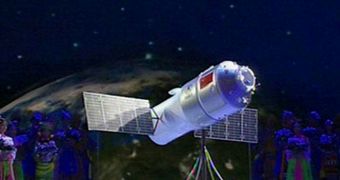China announced some time ago that it plans to start constructing a large space station as soon as its technology level allows. This year marks the beginning of a new stage in that plan, in the sense that it will be the first time when the country tests docking methods.
Orbital rendezvous are not simple to carry out, and the Chinese National Space Administration (CNSA) is adamant to work alone in this regard. It approved the orbital docking attempts scheduled for this year a couple of years back, when the first plans to construct the orbital facility were announced.
For 2011, the CNSA plans to launch the Tiangong-1 (Heavenly Palace) module to low-Earth orbit. This unmanned spacecraft will serve as a hub on which an upcoming Shenzhou-8 vehicle will attempt to affix itself to. That mission will be unmanned.
Getting a firm grip on rendezvous and docking technologies is a key aspect of the Chinese space program, and this is why the 2-year project to test them is a high-priority for the Asian nation.
At this point, the space station itself is scheduled to be completed by around 2020. The Tiangogn-1/Shenzhou-8 mission is just a prelude. Two more Shenzhou spacecraft are also scheduled to attach themselves to the orbital hub. These missions will be manned.
These announcements were made by China Astronaut Research and Training Center in Beijing professor and chief engineer Jiang Guohua, who spoke to attendants at the 15th annual International Space University symposium.
The conference was called “The International Space Station: Maximizing the Return from Extended Operations,” Space reports. CNSA made the official announcement that it had started working on its space facility in October 2010.
“Today, the RVD [rendezvous and docking] project is smoothly going through technical preparations and testing. Shenzhou-8 will be launched in October of this year,” Jiang told the conference.
Plans call for the two piloted flights to take place in 2012. If these time frames are respected, and the tests successful, then China would be on track to complete the space station in the time it allotted for itself.
Jiang also added that the station itself will be constructed between 2020 and 2022, and that it will most likely features a weight of about 60 tons. Its primary lifespan will be at least 10 years, he said.
“We will adhere to the policy of opening up to the outside world. We think some space scientific experiment items will be collected and selected from countries of the world which will promote international exchanges and cooperation,” he added.
“Scientists of all countries are welcome to participate in space science experimental research on China’s space station,” Jiang concluded.

 14 DAY TRIAL //
14 DAY TRIAL //